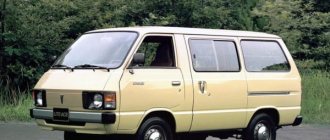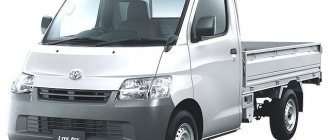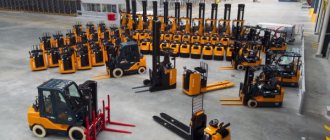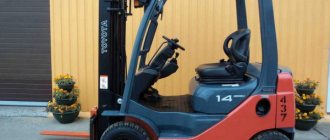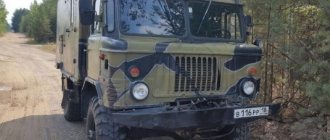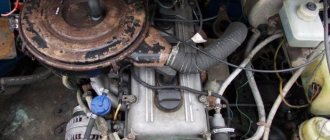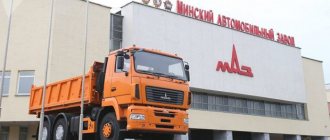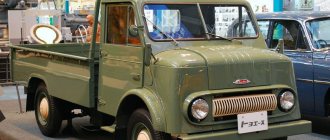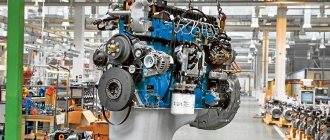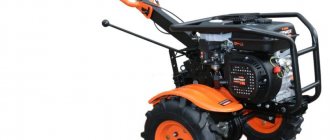The 3L engine belongs to the diesel L series of the Toyota manufacturer, which has distinctive features:
- SOHC timing mechanism with pushrods;
- drive of a single camshaft by a toothed belt;
- vortex type combustion chamber;
- layout for E class cars, light commercial vehicles, heavy minivans and jeeps;
- cast iron cylinder block.
General view of the 3L internal combustion engine assembled with attachments
The entire series is noisy, low-power, but very reliable, for example, 3L was often used for swapping UAZs, replacing the standard power drive.
Diesel Toyota B
The first internal combustion engine of the B series was a four-cylinder engine with a lower camshaft with a displacement of 2977 cm3. The cylinder block and head were made of cast iron. There is no direct injection or turbocharging. The camshaft is driven by a gear wheel.
By modern standards, this is a low-speed engine, with peak torque at 2200 rpm. Motors with such characteristics are ideal for overcoming off-road conditions and transporting cargo. Acceleration dynamics and maximum speed leave much to be desired. A Land Cruiser with such an engine could keep up with classic Zhiguli cars only up to a speed of 60 km/h, while rattling like a tractor.
Land Cruiser 40
The unconditional advantage of this engine can be considered its unsurpassed survivability. It works on any oil and digests almost any liquid that smells like diesel fuel. The engine is not prone to overheating: they describe a case where a Land Cruiser with such an engine worked for several months without any problems with a shortage of 5 liters of coolant.
The in-line high-pressure fuel pump is as reliable as the engine as a whole. Car service workers extremely rarely diagnose this unit; they believe that there is nothing to break there. The only trouble that arises over time is a shift in the fuel injection angle to a later direction due to wear of the timing gears and fuel injection pump camshaft. Adjusting the angle is not particularly difficult.
The most vulnerable components of the engine are the injector nozzles. They stop spraying fuel normally after about 100 thousand km. But even with such injectors, the car continues to start and drive confidently. At the same time, power is lost and smoke increases.
But you shouldn't do this. There is an opinion that faulty injectors cause coking of the piston rings, which will require a major engine overhaul. A complete overhaul of the engine, taking into account the cost of spare parts, will cost 1,500 USD. It is much easier to get the injectors in order.
The motor was installed on the following cars:
- Land Cruiser 40;
- Toyota Dyna 3,4,5 generations;
- Daihatsu Delta V9/V12 series;
- Hino Ranger 2 (V10).
3 years after the start of production, motor B underwent modernization. Version 11 B appeared, which used fuel injection directly into the combustion chamber. This decision increased engine power by 10 horsepower and torque increased by 15 Nm.
Model history
The first series of light trucks entered production in 1956 and had the index RK52. The car was created on the Toyota Toyopet platform, on which, by the way, the Toyopet Master passenger sedan was also produced.
The next series with indexes K70-K160 went on sale in 1959. It was from this series that the trucks acquired their own name Dyna.
With the launch of the next generation K170 in 1963, buyers were offered a choice of a 1.9-liter gasoline engine producing 80 hp. With. and a 2.3-liter diesel engine with 64 hp. With. A “heavy” modification of the Toyota Dyna also appeared with a longer wheelbase, a double tire rear axle and a load capacity of 2.5 tons.
The U10 series in 1968 already had two wheelbase options, three payload options and 3 engines to choose from: gasoline and two diesel. Minibuses were also produced on the basis of this chassis.
The new U20/Y20 series began to be sold in 1978 in a split version. Modifications U20-U50 had a carrying capacity of 2-3 tons, could be equipped with single or double rear wheels, a standard or wide cab. Modifications Y20-Y40 had a load capacity of 1-1.5 tons and a total weight of up to 3.5 tons.
The U60-Y50 series, launched in 1985, was also divided by tonnage. The “heavy” U60-U90 series had a load capacity of 2-3.5 tons. Light trucks with a total weight of up to 3.5 tons had indexes Y50-Y60. For the first time on Dyna models, a 5-speed transmission is standard. Cars produced before 1989 had round headlights, trucks from 1989-1995 had rectangular ones.
With the release of the new generation U100-Y100 in 1995, Dunes began to be imported en masse to Russia. As before, they differed in that the Y100 indices had models with a load capacity of 1-1.5 tons, the U100 indices had models with a load capacity of 2-3.5 tons. The production of trucks of this generation was completed in 2002.
The more modern Y200-U300 series began to be produced in 2000. The Y200 index meant a load capacity of 1-1.5 tons, the U300-U500 index meant a load capacity of 2-3.5 tons. The line of diesel engines was replenished with a hybrid modification. The Hino factories, owned by Toyota, began producing the Hino Dutro truck, an analogue of the Toyota Dyna.
The latest modification based on the 2000 series entered the production line in 2011 and received the indexes U600-U800.
Diesel Toyota 2B
In 1979, the next modernization was carried out, the 2B engine appeared. The engine displacement was increased to 3168 cm3, which gave an increase in power by 3 horsepower, and torque increased by 10%.
Toyota 2B
Structurally, the engine remained the same. The head and cylinder block were cast from cast iron. The camshaft is located at the bottom of the cylinder block. The valves are driven by pushers. There are two valves for each cylinder. The camshaft is driven using gears. The same principle applies to the oil pump, vacuum pump, and fuel injection pump.
This scheme is extremely reliable, but has increased inertia due to the large number of links. In addition, numerous parts produce significant noise. To combat it, the 2B engine used gears with oblique teeth, which were lubricated through a special nozzle. The lubrication system is gear type, the water pump is driven by a belt.
The 2B engine worthily continued the traditions of its predecessor. It is characterized as an extremely reliable, wear-resistant, unpretentious unit that is suitable for SUVs, light buses and trucks. The engine was installed on Toyota Land Cruiser (BJ41/44) and Toyota Coaster (BB10/11/15) for the domestic market until 1984.
Transmission and chassis
The front and rear suspensions are dependent, on leaf springs with hydraulic shock absorbers.
The drive is classic, to the rear wheels. For the domestic Japanese market there is an option with all-wheel drive.
Transmissions are manual, 5 and 6 speed. A version with an automatic transmission is available upon request.
The brake system is hydraulic, dual-circuit. Front brakes are ventilated discs. Rear drum type mechanisms.
Motor 3B
In 1982, the 2B was replaced by the 3B engine. Structurally, this is the same four-cylinder diesel engine with two valves per cylinder, in which the working volume is increased to 3431 cm3. Despite the increased volume and increased maximum speed, power dropped by 2 hp. Then more powerful versions of the engine appeared - 13B, equipped with direct fuel injection, and 13B-T, which has a turbocharger. In more powerful versions, a modernized pump of reduced size and a trochoid, instead of a gear, oil pump were installed.
Motor 3B
Between the oil pump and the filter on the 13B and 13B-T engines, an oil cooler was installed, which was an antifreeze-cooled heat exchanger. The changes led to an increase in the distance between the oil intake and the pump by almost 2 times. This slightly increased the engine's oil starvation time after startup, which did not have the best effect on durability.
Series 3B motors were installed on the following cars:
- Dyna (4th, 5th, 6th generation)
- Toyoace (4th, 5th generation)
- Land Cruiser 40/60/70
- Coaster bus (2nd, 3rd generation)
Engines 13B and 13B-T were installed only on the Land Cruiser SUV.
Advantages and disadvantages
Experts consider the internal combustion engine design of the entire L series, and the 3L in particular, to be very simple. Hence the undoubted advantages of the power drive:
- there is nothing to break here, there are known cases of mileage of over 30,000 km without a pump, that is, without cooling;
- combustion chambers may burst, but do not fall out of the cylinder head, the car drives in this condition;
- the timing belt is designed for 100,000 km, often 150 thousand without replacement, although experts recommend limiting the mileage to 60 thousand to avoid collision of pistons with valves;
- there are no intermediate shafts or pushers in the gas distribution system;
- you can add mineral oil without any consequences;
- crankshaft with a full set of counterweights;
- overheating is practically impossible.
The 3L engine has an extremely simple design of the gas distribution mechanism without pushers and intermediate shafts
The toothed belt rotates only the camshaft (the only one) and the fuel injection pump; the rest of the mounted ones have their own V-belts, which helps to increase the service life of these consumables.
The disadvantages include strong noise during operation due to the design of the combustion chambers and pin injectors, high diesel fuel consumption and an obsolete viscous coupling. Oil starvation is possible due to the long length of the oil receiver, through which fuel and lubricants are sucked in for too long.
Engine 4B
In 1988, the 4B series engines were introduced. The working volume increased to 3661 cm3. The increase was obtained by replacing the crankshaft, which increased the piston stroke. The diameter of the cylinders remained the same.
Structurally, the internal combustion engine was completely identical to its predecessor. This engine did not become widespread, mainly its modifications 14B with direct injection and 14B-T with turbocharging, which have higher power and efficiency, were used. The 4B engine in its pure form was significantly inferior to its competitors in these parameters. 14B and 14B-T were installed on Toyota Bandeirante, Daihatsu Delta (V11 series) and Toyota Dyna (Toyoace). Motors were produced until 1991, in Brazil until 2001.
4B
Design Features
The 3L naturally aspirated diesel engine received extremely simple technical solutions to facilitate the design:
- cast iron block with in-line arrangement of 4 cylinders;
- lightweight single-shaft cylinder head made of aluminum alloy;
- 8 valves without hydraulic compensators;
- SOHC gas distribution diagram without intermediate shaft and rocker arm;
- viscous coupling above the pump, the design of which was morally outdated already at the time of designing the internal combustion engine;
- well-arranged attachments that do not interfere with maintenance and repairs;
- reduced load on the timing belt due to the drive of only the injection pump and camshaft, everything else is rotated by its own poly-V belts;
- trochoid pump for oil supply, “long” lubrication system in the area of the oil receiver.
Standard cast iron cylinder block for 3L atmospheric diesel
Viscous coupling for atmospheric diesel 3L
The manufacturer did not carry out any modernization; the internal combustion engine has only one atmospheric version. An important feature of the power drive is the same size of cylinder diameter and piston stroke, therefore the internal combustion engine belongs to the “square” category, the service life is very long. This design solution simultaneously made it possible to increase the volume of the cylinders in comparison with previous versions of this series.
Engine 15B
The range of B series engines is completed by the 15B-F, 15B-FE, 15B-FTE motors, introduced in 1991. 15B-FTE is still produced and installed on the Toyota Megacruiser.
Toyota Mega Cruiser
In this engine, the designers abandoned the lower cylinder design and used a traditional DOHC system with narrow cams. The camshaft is located in the head above the valves. This scheme, using turbocharging and an intercooler, made it possible to achieve acceptable traction characteristics. Maximum power and torque are achieved at lower revs, which is what is required for a military all-terrain vehicle.
Advantages of repairs in the official service
Highly qualified craftsmen
- Employees of official service centers undergo training at the base.
Use only original parts
- Only high-quality, certified products with a manufacturer's guarantee.
- Genuine parts are parts that have passed multiple levels of testing to ensure they meet Toyota standards for quality and safety. Marriage is completely out of the question.
Carrying out work using special equipment
- The service center has all the necessary special tools and diagnostic equipment to service Toyota cars
Quality Standards
- Clear regulation of all service work
Work guarantee
- Maintain factory warranty
- 1 year warranty on original Toyota spare parts
- Guaranteed correct installation of parts by mechanics who have undergone professional training at the .
Post-warranty contract
- Extending your car's warranty to 2 years
Openness (open repair area)
- Transparent windows and special monitors in the service center allow you to monitor the process of car servicing
Express service
- This is a maintenance service in just 1.5 hours, in accordance with all quality standards
Direct acceptance
- Inspection of the front left side of the vehicle, including the condition of the interior
- Checking the functionality of electronic systems and devices, outdoor lighting
- Inspection of the roof on the left
- Inspection of the rear left side of the vehicle, including the condition of the interior
- Inspection of the roof on the right
- Inspection of the right side of the car, including the condition of the interior
- Inspect the rear of the car, including the trunk
- Vehicle inspection on a lift
- Inspection of the underbody, lower part of the front and rear bumper
- Inspecting wheels and measuring remaining tread depth
- Inspection of the engine compartment, boots, shock absorbers, brake and fuel lines, exhaust system
- The ability to calculate the cost of maintenance in 30 seconds without leaving home
- Carrying out maintenance in accordance with Toyota regulations
- Calculate the cost of body repairs for your car online
- After each maintenance, part of the amount is returned to your bonus account
- 3% for cars under warranty
- 5% for cars out of warranty
- vehicle service history
- bonus account
Specifications
Below is a summary table with the technical characteristics of the B series engines:
| Engine | Working volume, cm3 | Direct injection available | Presence of turbocharging | Availability of intercooler | Power, hp, at rpm | Torque, Nm, at rpm |
| B | 2977 | No | No | No | 80 /3600 | 191/2200 |
| 11B | 2977 | Yes | No | No | 90/ 3600 | 206/2200 |
| 2B | 3168 | No | No | No | 93 /3600 | 215/2200 |
| 3B | 3431 | No | No | No | 90/ 3500 | 217/2000 |
| 13B | 3431 | Yes | No | No | 98/ 3500 | 235/2200 |
| 13B-T | 3431 | Yes | Yes | No | 120/3400 | 217/2200 |
| 4B | 3661 | No | No | No | n/a | n/a |
| 14B | 3661 | Yes | No | No | 98/3400 | 240/1800 |
| 14B-T | 3661 | Yes | Yes | No | n/a | n/a |
| 15B-F | 4104 | Yes | No | No | 115/3200 | 290/2000 |
| 15B-FTE | 4104 | Yes | Yes | Yes | 153/ 3200 | 382/1800 |
Engine 1BZ-FPE
It’s worth mentioning this internal combustion engine separately. The 1BZ-FPE is a four-cylinder engine with a displacement of 4100 cm3 with a 16 valve head and two camshafts, which are driven by a belt.
The internal combustion engine was adapted to operate on liquefied gas - propane. Maximum power - 116 hp. at 3600 rpm. Torque is 306 Nm at 2000 rpm. Essentially these are diesel characteristics, with high thrust at low speeds. Accordingly, the engine was used in commercial vehicles such as Toyota Dyna and Toyoace. The power supply system is a carburetor. The cars performed their functions properly, but had a small range on gas.
Maintenance schedule 3L 2.8 l/91 l. With.
The manufacturer's manual states that the 3L engine should be serviced at the following intervals:
- timing belt - according to the developer, 100,000 km, in practice 60 thousand;
- It is recommended to adjust the thermal clearance of the valves every 30,000 miles;
- The manufacturer provides for cleaning the crankcase ventilation every 2 years;
- the developer recommends changing the engine oil after six months or 5000 km;
- the oil filter should be replaced after 10,000 miles;
- According to the manufacturer, the air filter must be replaced after 50,000 km, cleaned twice a year (trucks and pickups), annually (buses) or monthly (commercial vehicles);
- antifreeze from the factory is enough for 40,000 km or 2 years of operation;
- the fuel filter is updated after a mileage of 60,000 km;
- the resource of spark plugs in the DIS-2 engine system is 20,000 mileage;
- The walls of the exhaust manifold begin to burn out after 60,000 km.
3L maintenance should be carried out according to the manufacturer's manual within the specified time frame
Valve clearances are adjusted with washers; their values are 0.25 mm and 0.3 mm (intake/exhaust, respectively).
Reliability and durability of B series motors
There are legends about the indestructibility of these engines. A fairly simple design, a large margin of safety, and the ability to repair “on the knee” made these units indispensable in off-road conditions.
Turbocharged engines are not as reliable. Engine supercharging technology at that time did not reach the same degree of perfection as in our time. Turbine support bearings often overheated and failed. This can be avoided if you let the engine idle for a few minutes before turning it off, which was not always observed by everyone.
Price of a new and contract internal combustion engine
A 3L diesel costs 30 thousand rubles in adequate condition, tested by the manufacturer and brought to Russia. Here it is tested again by our experienced mechanics and only then goes on sale. It comes with a guarantee.
Since the motor is reliable and durable, even after a major overhaul, the 3L power unit is capable of traveling half a million km before it is completely replaced.
In general, a good and almost new motor can be found for a price of 60 or 70 thousand rubles. Such 3L engines have very low mileage. Therefore, the 3L engine will serve the new car owner for a long time.
